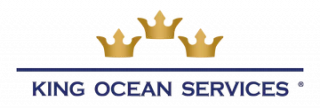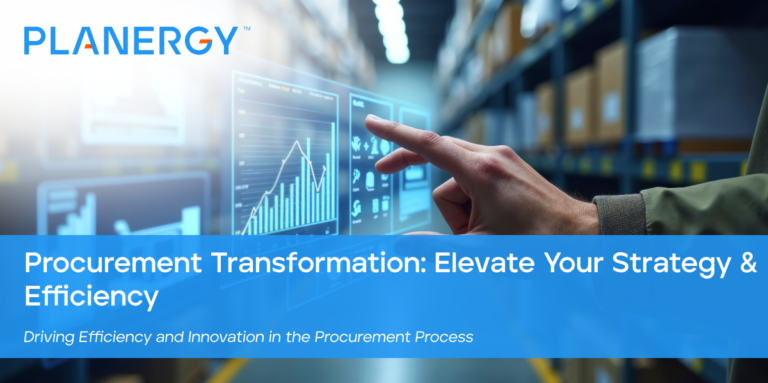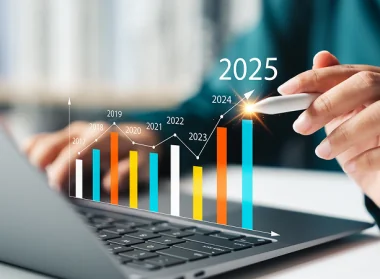Procurement transformation involves a complete overhaul of procurement processes to achieve greater efficiency and effectiveness.
It includes adopting new technologies, optimizing workflows, and building a more resilient procurement strategy.
Day and Atkinson explain procurement transformation as a specific type of organizational change management that focuses on strategies to enable major and long-term improvements to procurement and supply management processes, activities, and relationships.
Procurement transformation does not happen overnight.
Changing any system is complex and requires everyone’s cooperation to effectively change a business’s strategy and structure.
Developing a detailed procurement transformation roadmap is important so everyone is on the same page and the process can work as efficiently as possible.
The 7 Stages of Procurement Transformation
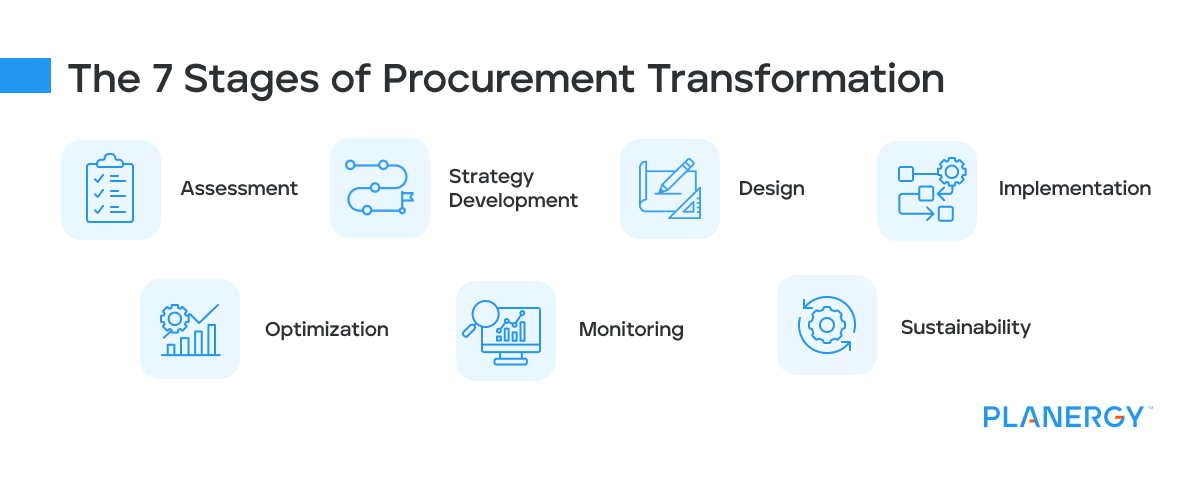
Assessment
Evaluate current processes and identify areas for improvement.
Begin thoroughly assessing your existing procurement practices to understand their strengths and weaknesses.
This evaluation involves gathering data, consulting with stakeholders, and reviewing key performance indicators (KPIs).
Consider people, processes, and technology.
Ask yourself:
- Do we have the right people to deliver today and in the future? Are the current procurement leaders equipped with everything they need to improve procurement performance?
- What skills do our people need to excel in their positions?
- What do our people need to get their jobs done better, faster, and more accurately?
- Do we have the right processes in place to get the job done today and in the future?
- In our current state, do we have consistent and repeatable processes in place, and are they as efficient as possible?
- Does our technical structure align with and support the needs of our organization?
- Do we have the right technology to execute? Investing in the tools may impact the bottom line initially, but they will likely be more cost-effective in the end.
Conduct a spend analysis to determine how much you’re spending and where you’re spending it.
Then, look at your organizational structure to see if there is a more efficient way to ensure everyone gets what they need.
Look at your sourcing strategy to make sure you’re maximizing savings.
Identifying inefficiencies, bottlenecks, and compliance issues will highlight areas that require change, setting the groundwork for a more effective procurement strategy.
Strategy Development
Formulate a strategic plan aligned with business goals.
Based on the insights gathered during the assessment phase, develop a comprehensive strategy that aligns with your procurement organization’s objectives.
This plan should outline clear goals, timelines, and necessary resources.
By aligning the procurement strategy with broader business goals, you ensure that procurement activities support overall organizational success and drive long-term value.
Design
Map out new processes and select appropriate technologies.
The design phase involves creating detailed workflows for the new procurement processes, ensuring they address the identified areas for improvement.
Selecting the right technologies is crucial; choose tools that integrate seamlessly with your existing systems and offer the functionalities needed to enhance efficiency and compliance.
Detailed process maps and technology roadmaps will guide the successful implementation of these new systems.
Implementation
Deploy the new processes and technologies. With a well-defined strategy and design, move forward with implementing the changes.
This phase includes configuring new software, training staff, and rolling out updated procedures across the organization.
Careful planning and communication are vital to ensure a smooth transition, minimize disruptions, and encourage stakeholder buy-in.
Optimization
Continuously refine and improve the procurement processes. Implementation is not the end—ongoing optimization ensures that procurement processes remain efficient and effective.
Review performance metrics regularly and gather user feedback to identify opportunities for further enhancements.
Agile methodologies can be beneficial here, allowing for iterative improvements that quickly adapt to changing needs and conditions.
Monitoring
Track performance and ensure compliance. Establish robust monitoring systems to oversee the new procurement processes.
This involves tracking KPIs, conducting regular audits, and ensuring regulatory and internal standards adherence.
Effective monitoring helps maintain high performance levels and promptly addresses any deviations or issues, safeguarding the integrity of the procurement function.
Sustainability
Maintain the transformed processes and ensure they adapt to future needs. Sustainability is about keeping the momentum of transformation going.
Develop strategies to ensure the new processes are resilient and adaptable to future challenges.
This includes continuous training programs, regular process reviews, and staying abreast of technological advancements and market trends.
Focusing on sustainability ensures that your procurement processes remain relevant and can support long-term business growth.
Procurement Transformation Roadmap
A roadmap outlines the strategic steps necessary for achieving procurement transformation.
It is a comprehensive guide detailing each critical phase and ensuring all activities align with your organization’s vision.
Goals and Objectives
Define what the transformation aims to achieve.
Establishing clear goals and objectives is the foundation of any successful transformation.
These goals should be specific, measurable, achievable, relevant, and time-bound (SMART).
Whether the aim is to reduce costs, improve efficiency, enhance compliance, or strengthen supplier relationships, having well-defined objectives provides direction and motivation for the entire team.
Deloitte have identified many areas where digitization and procurement transformation can improve how a company does business, specifically optimizing its purchasing process.

Source to Contract (S2C)
- Predict demand with artificial intelligence
- Categorize and manage spend in real time
- Know landed cost for any commodity for all alternate countries of origin
- Predict sources of future innovation
- Act on timely alerts from all negotiated agreements (indexed pricing, penalties, renewals, etc.) through smart contracts
Procure to Pay (P2P)
- Automatically sense material demand and consumption and requisition replenishment deliveries from suppliers
- Exchange goods through validated and trusted decentralized ledgers
- Eliminate repetitive processing through robotic process automation
- Trigger payments utilizing real-time signals of material delivery
- Execute automated secure payment
Supplier Relationship Management (SRM)
- Monitor potential for risks in real-time through the aggregation and visualization of third-party data feeds
- Conduct supplier visits from their own office utilizing augmented reality
- Perform supplier audits through crowdsourcing
- Monitor sustainability across entire ecosystems through automatic reporting and visualization
Timeline
Establish key milestones and deadlines.
A detailed timeline is essential for maintaining momentum and ensuring timely progress.
Break down the transformation process into manageable phases with tasks and deadlines.
This includes short-term wins to build confidence and long-term goals to maintain focus.
Regularly reviewing and adjusting the timeline helps keep the project on track and allows for flexibility in response to unforeseen challenges.
Resources
Identify the required resources, including technology and personnel.
Successful procurement transformation depends on having the right resources in place.
This includes investing in advanced technologies such as automation tools, data analytics platforms, and cloud-based solutions.
Equally important is assembling a skilled team capable of driving the transformation forward.
Identify the necessary personnel, provide appropriate training, and ensure everyone understands their roles and responsibilities.
Metrics
Set KPIs to measure the transformation’s success. KPIs are vital for tracking progress and evaluating the transformation’s impact.
Determine which metrics best align with your goals: cost savings (and cost reduction), cycle time reduction, supplier performance, and compliance rates.
Regularly monitor these KPIs to assess the effectiveness of the transformation efforts and make data-driven decisions.
Transparent reporting and analysis foster accountability and continuous improvement across the organization.
Building a Resilient Procurement Transformation Strategy
A resilient strategy ensures procurement processes can withstand disruptions and adapt to changes.
By focusing on key elements such as flexibility, risk management, and technology integration, you can create a robust procurement framework capable of navigating uncertainties and maintaining operational efficiency.
Flexibility
Design processes that can easily adapt to new conditions.
Flexibility is crucial for resilience, allowing procurement operations to respond swiftly to changing market dynamics, supplier issues, and internal shifts.
This can be achieved by developing modular processes that can be reconfigured as needed without overhauling the entire system.
Encourage a culture of agility where continuous improvement and rapid adaptation are ingrained in daily practices.
Regularly review and update procurement policies to ensure they remain relevant and practical under varying circumstances.
Risk Management
Implement measures to mitigate risks and ensure continuity.
A comprehensive risk management framework is essential for identifying potential threats and minimizing their impact.
Start by conducting a thorough risk assessment to pinpoint vulnerabilities within the procurement process, including supplier reliability, geopolitical factors, and economic fluctuations.
Develop contingency plans for different scenarios, ensuring clear protocols for action.
Implement strategies such as diversifying the supplier base in the event of supply chain disruptions, creating buffer stocks to prevent shortages, and establishing solid contractual terms to safeguard against disruptions.
Regularly review and test these measures to ensure they are effective and up-to-date.
Technology Integration
Leverage advanced technologies to enhance resilience. Integrating cutting-edge technologies can significantly bolster procurement resilience.
Utilize automation tools to streamline routine tasks, reducing the dependency on manual interventions and minimizing the risk of errors.
Advanced data analytics can provide real-time insights into supply chain performance, enabling proactive decision-making and early identification of potential issues.
Cloud-based solutions offer scalability and accessibility, ensuring procurement data and operations remain uninterrupted even during physical disruptions.
Invest in cybersecurity measures to protect sensitive information and maintain trust with suppliers and stakeholders.
Challenges with Procurement Transformation

Complexity
Transformation in procurement has been around for a long time, but it has only recently become a hot topic.
It is not a very well understood concept as it is relatively vague and quite complex so it is not always easy to follow.
Creating a detailed roadmap to follow helps reduce any confusion that may arise during procurement transformation.
Short-Term Drawbacks
Disrupting an enterprises system or process may be beneficial in the long run, but be accompanied by short-term drawbacks.
For example, while the company is still getting used to the new system in place it may not perform as well as usual because of the unfamiliarity of the situation.
These short-term setbacks, however, will be offset by the long-term benefits the company reaps from procurement transformation.
Length of the Process
Procurement transformation takes time.
Fulfilling all of a company’s goals may be time-consuming and costly, but ultimately, the long term benefits of the transformation makes the lengthy process worth it.
Best Practices for Successful Procurement Transformation
Achieving a successful procurement transformation requires a well-rounded approach incorporating stakeholder engagement, data-driven decisions, continuous improvement, and robust training programs.
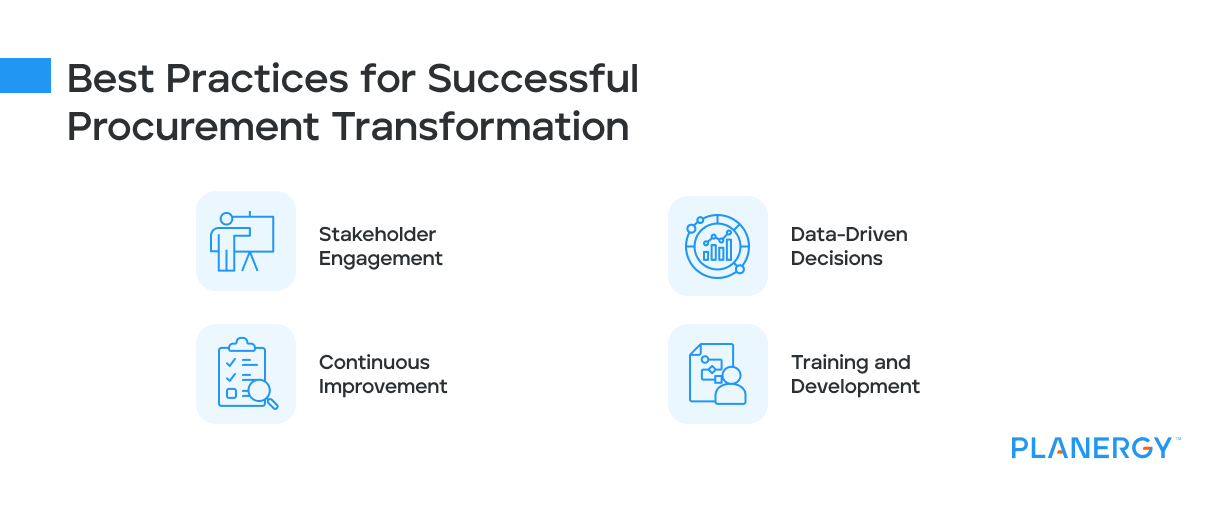
Stakeholder Engagement
Involve all relevant stakeholders to gain buy-in and support. Effective procurement transformation and change management hinges on the active involvement of stakeholders from across the organization.
Engaging stakeholders early in the process ensures that their insights and concerns are considered, fostering a sense of ownership and commitment.
Create a communication plan that keeps stakeholders informed and involved at every stage of the transformation.
Regular meetings, workshops, and feedback sessions can help build consensus and drive alignment with the overall strategic goals.
Data-Driven Decisions
Use data analytics to inform decision-making and track progress.
Leveraging data analytics is crucial for making informed decisions and measuring the success of procurement initiatives.
Collect and analyze data from various sources to gain insights into spending patterns, supplier performance, and process efficiencies.
Develop KPIs to track progress and identify areas for improvement.
Advanced analytics tools can also predict trends and provide actionable recommendations, helping you stay ahead of challenges and capitalize on opportunities.
Continuous Improvement
Review and refine procurement processes regularly.
Continuous improvement is essential for maintaining the effectiveness and efficiency of procurement operations.
Establish a culture that prioritizes regular evaluation and refinement of processes.
Use feedback from stakeholders and performance data to identify bottlenecks and areas for enhancement.
Implement agile methodologies that allow for iterative improvements, ensuring that procurement practices evolve in response to changing conditions and emerging best practices.
Training and Development
Equip your team with the necessary skills and knowledge.
The success of procurement transformation depends significantly on your team’s capabilities.
Invest in comprehensive training and development programs to ensure your staff has the latest skills and knowledge.
Offer ongoing education opportunities, such as workshops, certifications, and e-learning courses, to keep your team updated on industry trends and technological advancements.
Encourage a learning culture where team members continuously seek to enhance their expertise and contribute to the organization’s success.
Unlock Procurement Transformation with Process Automation
Process automation is a critical enabler of procurement transformation.
Automating repetitive tasks can achieve greater efficiency, accuracy, and cost savings.
Optimizing procurement with a cloud-based P2P solution is a strategic move that can significantly benefit your organization.
Consider embarking on a comprehensive digital procurement transformation journey to unlock the full potential of your procurement processes.
